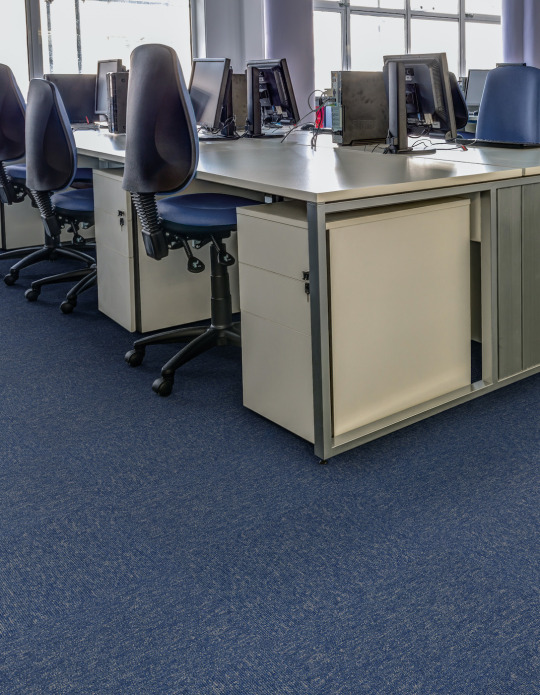Text
How to Measure Carpet
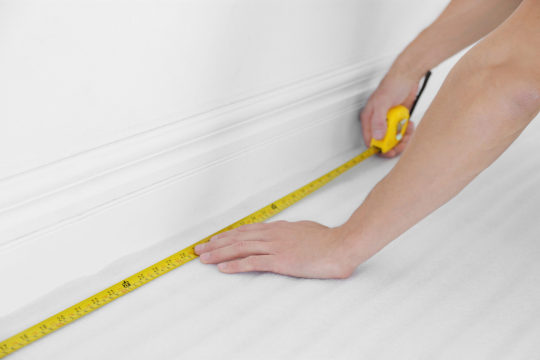
Introduction
Carpets have the potential to transform a room by adding a touch of luxury, increasing warmth and creating a sense of homeliness. But before you dive into choosing carpet colours, patterns and designs, you need an accurate set of measurements so you can determine how much carpet you will need for your space. This guide aims to provide you with the required knowledge that you need to accurately measure your space, so you can move onto the next exciting step of choosing your perfect carpet!
Carpet Measuring Steps
1. Gather Tools: To measure a carpet, you will need a tape measure and a notepad and pen (or a phone these days). A calculator is optional, but it will make the process easier if you struggle with numbers.
2. Length and Width: Start by measuring the length and width of your room using your tape measure. If your room is rectangular, this process should be fairly straight forward. Try to measure length from two points and width from two points. This allows you to double check measurements and account for any variations in the room. If your room is not rectangular, you could either measure the longest point lengthways and the longest point widthways or break your space down into smaller rectangles that you can measure separately.
3. Doorways: Don’t forget to factor into doorways into your measurement.
4. Irregularities: Don’t forget to measure any irregularities in your room, such as bay window, alcoves, permanent furniture, etc…
5. Buffer: It is advised to add a buffer amount of carpet to account for any irregularities in the room or inaccurate measurements. A good rule of thumb would be adding 10cm to both the length and width measurements to give you or your carpet fitter some excess carpet to work with. Some carpet fitters will recommend the rule of adding an extra 10% as a buffer to your measurements. It is up to you which rule of thumb you choose to follow, but adding a buffer is definitely recommended.
6. Calculate: Now you need to calculate how many square meters of carpet you need to cover your room. To do this multiple the length measurement with the buffer added against the width measurement with the buffer added. If you have an irregularly shaped room, break the area down into smaller rectangles and calculate the area of each rectangle before adding them all together to get your overall area.
Tips for Carpet Measuring
• Right Angles: Ensure your measuring tape is perpendicular to the walls you are measurement against for length and width.
• Measure Multiple Times: The phrase “measure twice, cut once” comes in here. Be safe and double (maybe even triple) check your measurements.
• Use a Calculator: Avoid human error when calculating your floor area by using a calculator to help you.
• Consult a Professional: Carpet is probably one of the most difficult flooring types to measure and install, so consider using a carpet fitter to do the job for you. At Flooring Hut, we offer a supply and fit service. This means you can purchase your wonderful carpet through us and then select a local and vetted carpet fitter to install your carpet for you through us too.
Conclusion
So there you have it, our guide to accurately measuring your space for carpet installation. Gather your tools, remember to measure multiple times, get your calculator out and good luck! At Flooring Hut, we highly recommend getting a flooring a professional to install your carpet for you and we welcome you to browse our extensive range of carpets to select the perfect one for your space. If you need a guide on how to DIY install carpets you can find that here and if you want to know how to maintain your carpets in tip-top condition then you can click here. We hope you will enjoy your carpet for many years to come!
Read the full article
0 notes
Text
Removing Carpet Stains with Household Products
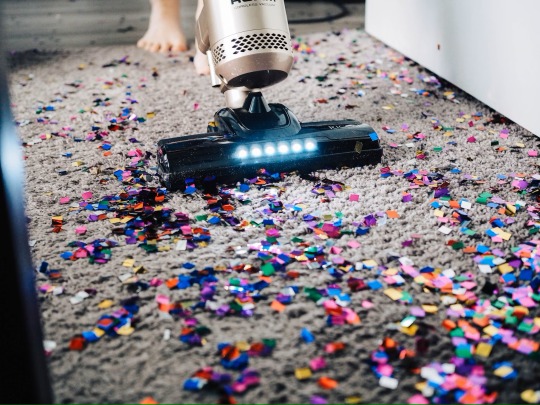
Introduction
Disaster has struck and your beautiful carpet has been soiled by spilt food and drink or maybe by a pet relieving itself. But before you go out and buy some harsh chemicals to clean your carpet, you may be surprised to find that with some common household products that you may have lying around in your cupboards, you could remove those stubborn stains in an environmentally-friendly way. This guide aims to show you the common household products that are effective carpet stain removers and the common household carpet stains that occur and pair the stain with the remover for effective treatment.
Common Household Stain Removers
• White Vinegar: White vinegar is a triple threat as it is not just a stain remover, but also a natural disinfectant and deodoriser too.
• Baking Soda: Baking soda can absorb liquid stains, such as oil and grease. It can also be sprinkled on your carpet at regular intervals and left for 15 minutes before vacuuming up for a deeper clean that removes odours.
• Washing Up Liquid: Harsh enough to lift stains, but gentle enough to not discolour fibres or harm pets, washing up liquid is a great go to stain remover that everyone has at home.
• Club Soda: An unusual choice, but the carbonation of club soda can help lift stains out of the carpet fibres.
• Cornstarch: Similar to baking soda, this powder can absorb liquid stains and then be removed by blotting or vacuuming.
• Ice Cubes: Ice cubes can help cool and harden gum or wax that may be caught in your carpet’s fibres.
• Shaving Cream: Believe it or not, shaving cream is great for lifting oil and grease stains out of carpets.
• WD-40: WD-40 is a good backup for removing gum and wax if ice cubes are not working for you.
Common Household Carpet Stains and Matching Remover
• Tea and Coffee: Everyone loves tea and coffee, but nobody likes a tea or coffee stain. If you do spill one or both of these liquids on your carpet, then reach for your white vinegar. Mix the white vinegar with equal parts water and apply to the affected area. Leave it for a few minutes then blot the stain. Rinse clean with water, then blot the carpet dry. Job done!
• Pet Pee: Your beloved cat or dog has had a bladder accident, what do you do? Start by blotting the excess urine. Then mix a solution of two parts white vinegar and one part water and use it to blot the affected area. Remember to leave it a few minutes to allow the solution to work. Next mix a solution of half a cup of water and quarter of a cup of baking soda and blot the affected the area. Again, remember to leave the solution for a few minutes for maximum effect. The white vinegar should lift the stain and the baking soda should neutralise the odour. Rinse and blot dry.
• Wine and Beer: Once again, most people love drinking wine and beer, but hate wine and beer stains. If your drink does take a tumble, then act quickly and reach for the club soda. Pour the club soda on the affected area and let it fizz for a few minutes. Then blot the affected area. Once the stain is removed, rinse with water and blot dry.
• Grease and Oil: If your grease and/or oil stain has a lot of liquid, then reach for either baking soda or cornstarch. Both of these powders can help absorb the excess oil and grease. Out of the two, baking soda is better as it also has a deodorising effect. You can then vacuum the stain or blot it out of your carpet fibres. If the grease and/or oil stain is stubborn, then reach for some shaving cream. Apply a small amount of shaving cream onto the stain, then leave it for a few minutes. Blot the affected area, then use a solution of equal parts water and white vinegar to clean the affected area. Rinse and blot dry and your carpet should be good as new again.
• Gum and Wax: Gum and wax can be tricky to remove from carpet fibres. Your first port of call should be to reach for some ice cubes and place them in a plastic bag. Place the plastic bag onto the wax and gum, this should cool it and hopefully harden it. Once hardened, you can scrape of the wax and/or gum with a blunt knife. If this does not work effectively, then reach for some WD-40. Spray a little bit on the wax and/or gum and let it sit for a few minutes. Again, use your blunt knife to scrape off the wax and/or gum. You can then rinse and blot dry the affected area.
• Chocolate: Everyone’s favourite treat, but if you spill some on your carpet then reach for your washing up liquid. Mix one teaspoon of washing up liquid with one cup of water. Blot the stain, then rinse with water and blot dry. If there is any remaining stain, then mix a paste of equal parts water and baking soda. Apply the paste to the stain, let it dry fully, then vacuum it off. This will also help remove any lingering odours too.
Conclusion
So there you have it, if disaster strikes and you stain your lovely carpet with the help of this guide you can try tackling the stain with some common products that you might have at home. If these home remedies do not work for you, then consider buying proper carpet cleaning products to help you remove the stain. If in doubt, you could always consult a professional carpet cleaner and get them to remove the stain for you. If you are tackling the stain yourself, then remember the golden rule of carpet stain removal: blot. Never rub the stain, instead blot (dab) it starting from the outside edge of the stain and working towards the middle of the stain to stop it from spreading. It is always a good idea to test any homemade solutions on an inconspicuous part of your carpet to check for discolouration before using it on a more obvious part of your carpet. Armed with this guide, you should be able to tackle a variety of common carpet stains with effective and environmentally-friendly homemade carpet cleaning solutions.
Read the full article
0 notes
Text
Removing Carpet Stains with Household Products
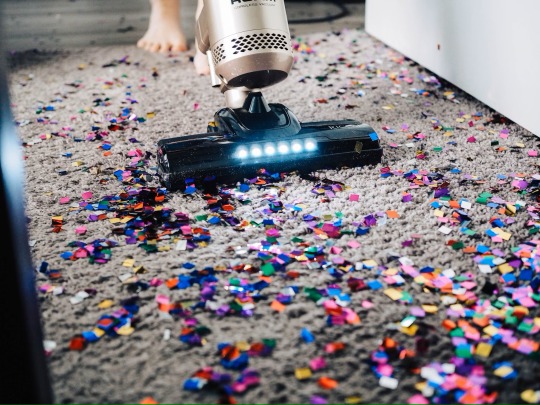
Introduction
Disaster has struck and your beautiful carpet has been soiled by spilt food and drink or maybe by a pet relieving itself. But before you go out and buy some harsh chemicals to clean your carpet, you may be surprised to find that with some common household products that you may have lying around in your cupboards, you could remove those stubborn stains in an environmentally-friendly way. This guide aims to show you the common household products that are effective carpet stain removers and the common household carpet stains that occur and pair the stain with the remover for effective treatment.
Common Household Stain Removers
• White Vinegar: White vinegar is a triple threat as it is not just a stain remover, but also a natural disinfectant and deodoriser too.
• Baking Soda: Baking soda can absorb liquid stains, such as oil and grease. It can also be sprinkled on your carpet at regular intervals and left for 15 minutes before vacuuming up for a deeper clean that removes odours.
• Washing Up Liquid: Harsh enough to lift stains, but gentle enough to not discolour fibres or harm pets, washing up liquid is a great go to stain remover that everyone has at home.
• Club Soda: An unusual choice, but the carbonation of club soda can help lift stains out of the carpet fibres.
• Cornstarch: Similar to baking soda, this powder can absorb liquid stains and then be removed by blotting or vacuuming.
• Ice Cubes: Ice cubes can help cool and harden gum or wax that may be caught in your carpet’s fibres.
• Shaving Cream: Believe it or not, shaving cream is great for lifting oil and grease stains out of carpets.
• WD-40: WD-40 is a good backup for removing gum and wax if ice cubes are not working for you.
Common Household Carpet Stains and Matching Remover
• Tea and Coffee: Everyone loves tea and coffee, but nobody likes a tea or coffee stain. If you do spill one or both of these liquids on your carpet, then reach for your white vinegar. Mix the white vinegar with equal parts water and apply to the affected area. Leave it for a few minutes then blot the stain. Rinse clean with water, then blot the carpet dry. Job done!
• Pet Pee: Your beloved cat or dog has had a bladder accident, what do you do? Start by blotting the excess urine. Then mix a solution of two parts white vinegar and one part water and use it to blot the affected area. Remember to leave it a few minutes to allow the solution to work. Next mix a solution of half a cup of water and quarter of a cup of baking soda and blot the affected the area. Again, remember to leave the solution for a few minutes for maximum effect. The white vinegar should lift the stain and the baking soda should neutralise the odour. Rinse and blot dry.
• Wine and Beer: Once again, most people love drinking wine and beer, but hate wine and beer stains. If your drink does take a tumble, then act quickly and reach for the club soda. Pour the club soda on the affected area and let it fizz for a few minutes. Then blot the affected area. Once the stain is removed, rinse with water and blot dry.
• Grease and Oil: If your grease and/or oil stain has a lot of liquid, then reach for either baking soda or cornstarch. Both of these powders can help absorb the excess oil and grease. Out of the two, baking soda is better as it also has a deodorising effect. You can then vacuum the stain or blot it out of your carpet fibres. If the grease and/or oil stain is stubborn, then reach for some shaving cream. Apply a small amount of shaving cream onto the stain, then leave it for a few minutes. Blot the affected area, then use a solution of equal parts water and white vinegar to clean the affected area. Rinse and blot dry and your carpet should be good as new again.
• Gum and Wax: Gum and wax can be tricky to remove from carpet fibres. Your first port of call should be to reach for some ice cubes and place them in a plastic bag. Place the plastic bag onto the wax and gum, this should cool it and hopefully harden it. Once hardened, you can scrape of the wax and/or gum with a blunt knife. If this does not work effectively, then reach for some WD-40. Spray a little bit on the wax and/or gum and let it sit for a few minutes. Again, use your blunt knife to scrape off the wax and/or gum. You can then rinse and blot dry the affected area.
• Chocolate: Everyone’s favourite treat, but if you spill some on your carpet then reach for your washing up liquid. Mix one teaspoon of washing up liquid with one cup of water. Blot the stain, then rinse with water and blot dry. If there is any remaining stain, then mix a paste of equal parts water and baking soda. Apply the paste to the stain, let it dry fully, then vacuum it off. This will also help remove any lingering odours too.
Conclusion
So there you have it, if disaster strikes and you stain your lovely carpet with the help of this guide you can try tackling the stain with some common products that you might have at home. If these home remedies do not work for you, then consider buying proper carpet cleaning products to help you remove the stain. If in doubt, you could always consult a professional carpet cleaner and get them to remove the stain for you. If you are tackling the stain yourself, then remember the golden rule of carpet stain removal: blot. Never rub the stain, instead blot (dab) it starting from the outside edge of the stain and working towards the middle of the stain to stop it from spreading. It is always a good idea to test any homemade solutions on an inconspicuous part of your carpet to check for discolouration before using it on a more obvious part of your carpet. Armed with this guide, you should be able to tackle a variety of common carpet stains with effective and environmentally-friendly homemade carpet cleaning solutions.
Read the full article
0 notes
Text
The Less Luxurious Side of Luxury Vinyl Tiles

Why are Luxury Vinyl Tiles So Popular?
Luxury vinyl tile (LVT) has gained immense popularity in recent years due to its affordability, durability, and ease of maintenance. However, like any other flooring option, LVT is not without its drawbacks. So, before you jump on the bandwagon and replace your entire property with LVT, let’s delve into the disadvantages of luxury vinyl tile flooring to help you make an informed decision when choosing the right flooring for your home or business.
Disadvantage 1 – Cheap, but Not So Cheap
While luxury vinyl tiles boast affordability compared to real hardwood, it's not as cheap as say laminate flooring. Laminate flooring may set you back around £20 per square metre. Whereas, decent luxury vinyl tiles will cost £30+ per square metre . Not exactly breaking the bank, but once you factor in the cost of underlay and a flooring professional to fit the tiles the price will add up. But remember installing LVT is an investment for you and your property. At Flooring Hut, we are proud to off a supply and fit service. Interested in taking the hassle out of laying floors? Click here: supply and fit service.
Disadvantage 2 – Tricky to Fix
Hopefully, you have paid for a professional installation and your luxury vinyl tile flooring is laid correctly and looks amazing. But what if a few months or years down the line a tile becomes accidentally damaged. Unlike hardwood, where sanding and refinishing can work wonders, repairing LVT often involves replacing entire planks, which can be time-consuming and costly. That being said, if you look after your floor properly, then this should be an unlikely event for you.
Disadvantage 3 – Environmental Concerns
Luxury vinyl tiles are primarily a PVC product, raising environmental concerns. While some manufacturers offer eco-conscious options, traditional LVT contributes to plastic waste and isn't readily biodegradable. If sustainability is a priority, explore alternatives like hardwood, cork or bamboo flooring. These alternatives are often sourced from renewable materials and have a lower environmental impact, making them a more sustainable choice for environmentally conscious consumers. At Flooring Hut, we offer real hardwood flooring for our environmentally conscious customers.
Disadvantage 4 – Beauty is in the eye of the beholder
Despite advances in design, some LVT can still scream "fake." While the textures and patterns get better every day, you might find yourself yearning for the genuine look and feel of natural materials like wood or stone. Furthermore, luxury vinyl tiles are susceptible to the effects of sunlight and prolonged exposure can lead to fading or discoloration. UV-resistant coatings may help mitigate this issue, but it is essential to be aware of the potential for fading over time. Flooring Hut’s own range of luxury vinyl tiles have been carefully chosen to scream “aesthetic” when laid down and have been UV coated to ensure longevity of colour.
What will you choose?
Luxury vinyl tile flooring offers numerous benefits and remains a popular choice for a reason, but being aware of its limitations empowers you to make an informed decision for your home or business. Remember, these "disadvantages" might not be dealbreakers for you. Weigh these factors against your needs, budget and priorities. At Flooring Hut, we believe in transparency and being honest with customers. We hope this article has helped you make an informed choice about whether luxury vinyl tiles are the right flooring choice for you.
ENDS
Read the full article
0 notes
Text
Carpet Trends: Colours and Patterns
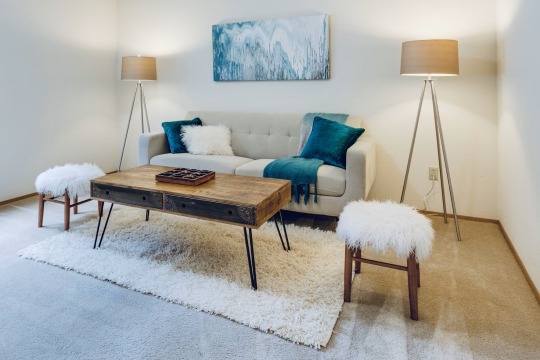
Introduction
The sheer range of carpet designs, colours and patterns available these days can be overwhelming. From timeless neutrals to bold colours, from natural to pastel colours, and from striped to square patterns – how do you pick the perfect carpet for your home or office space? This guide aims to cover the main carpet trends looking at colour and pattern, so you can pick the perfect carpet for your space.
Timeless Neutrals
Neutral carpets have a timeless quality. By using neutral colours, such as beige, grey and ivory white, these carpets can fit in practically any room and match virtually any décor. Additionally, these colour palettes create a calming, relaxing and welcoming space providing a minimalist and classic feel to your space. Furthermore, if your space is smaller in size, then you will be glad to know that neutral carpets can create a sense of light, airiness and spaciousness helping to make a room feel bigger than it is. So if you are after a timeless carpet to create a classic look which enlarges the feel of your space, then a neutral carpet is the choice for you!
Bold Colours
If you want your floor to make a statement, then do not shy away from bold coloured carpets. In the interior design world, strong colours like sapphire, emerald and amethyst are increasing in popularity. Colours previously considered outside of the box in design terms, such as teal, mustard yellow and even pink are being used by designers to give a room that “wow” factor. Of course, with a bold coloured carpet more consideration is needed when choosing matching furniture and décor, but when done properly you can create an eye-catching room. So if you like to express yourself through strong colours and want a space that makes your guest’s jaw drop then bold coloured carpets are for you!
Natural Colours
Similar to neutral colours, natural colours use the design palette that Mother Nature provides. Earthy tones, such as terracotta, olive green, pale blue and deep browns create a holistic space. Natural carpets pair really well with wooden furniture and décor creating an organic feel that blends the outdoors with the indoors. So if you love oak, mahogany and teak furniture, then natural coloured carpets are the way to go for you!
Pastel Colours
If you take the colour choices of bold carpets and seriously tone down the intensity of the colour then you get pastel-coloured carpets. Baby blues, mint greens, rose pinks and lavender purples are popular pastel colours. With the lack of colour intensity, pastel carpets create a warm, calm and romantic atmosphere in a room. Perfect for bedrooms and living rooms. So if you are an old school romantic who loves calm spaces, then pastel coloured carpets will make your day!
Patterned Carpets
Setting colours aside for a moment, let’s discuss patterns. The above colours (neutral / bold / natural / pastel) tend to come as solid-coloured carpets. However, patterned carpets, such as striped, squared or even geometric patterns are growing in popularity. Let’s take a look at each pattern individually.
• Stripes: From pin-stripes to wide bands, striped carpets come in a range of design choices. You can choose complementary strips or contrasting stripes, depending on the feel you want to create. Remember that horizontal stripes can make a room feel wider, whilst vertical stripes can give the illusion of height in a space.
• Squares: Sometimes referred to as checked or chequered carpets. Again, there are different choices in terms of the thickness of the squares and the colours (complimentary or contrasting). These carpets provide an angular, interesting element within a space.
• Geometric: More modern and fun. Geometric carpets can have hexagonal patterns, herringbone patterns, chevron patterns, the list goes on… These carpets add a modern, stylish vibe to space and definitely becomes the centrepiece of a room and a talking point.
Conclusion
To sum up, when it comes to carpet design there are two main aspects to consider: colour and pattern. If you want to make a statement that expresses your personality, choose bold or pastel colours. However, if you want to create a timeless classic feel in your room, then choose natural or neutral colours. If you want your carpet to be eye-catching and a talking point, consider patterned carpets. You could opt for the tried-and-tested striped or squared patterns. Alternatively, you create a modern aesthetic with a geometric patterned carpet. Whatever design you choose, we hope you enjoy your new carpet for many years to come!
Read the full article
0 notes
Text
Why Carpets Are Better Than Hard Floors

Introduction
In the world of flooring, you can split your choices into two categories: hard floors and soft floors. Hard floors include laminate, luxury vinyl tiles, real wood and stone. On the other hand, soft flooring refers to carpet (both sheet and tiles). Choosing whether to go with soft or hard flooring for your home or workspace is a personal choice that is influenced by many factors. In this article, we will deal with the advantages that soft floors (carpets) have over their hard floor rivals, with a particular focus on the home environment.
Advantages of Carpet
• Comfort: In terms of comfort underfoot, carpets are far superior to their hard floor rivals. Where laminate, LVT and real wood floors can feel hard, cold and uninviting; carpet feels warm, soft and welcoming. Carpet is particularly useful for rooms you spend a lot of time in, such as living rooms or for rooms you want to give a luxurious feel to, such as bedrooms. Carpet also benefits families with young kids who spend a lot of time on the floor and elderly family members who will benefit from the added shock absorption carpet provides for their joints.
• Quiet: Did you know that carpet has noise reducing effects? Carpet fibres can absorb sound creating a quieter living space. This is particularly useful in house with many floors or if you are living in a flat with neighbours around you. Carpet can absorb ambient sounds (sound from the environment, such as a TV) and impact sounds (sound from footfall or something falling over).
• Safety: Carpets are safer than their hard floor counterparts because of their slip resistance. The textured surface of the carpet’s piles provides additional grip making it harder to slip over on. This is particularly useful for staircases. Also, for households with young children carpet provides extra grip when learning to walk and for households with elderly people carpet provides cushioning for accidental falls.
• Insulation: Did you know that carpets are a natural insulator? In the winter months, the carpet fibres can trap warm air retaining heat inside a room. On the other hand, in summer, carpets can retain the cool air in the room. This makes carpets an energy-efficient flooring choice that can save you money on heating bills in winter and cooling bills in summer. This will also make your house more environmentally friendly.
• Design: Carpets come in a range of designs. From solid natural colours that have a timeless appeal to bold pattern designs that capture a room’s personality. This is not necessarily a clear advantage over hard flooring, which offers lots of design choices. However, it still must be stated that carpets have a wide range of design choices available, ensuring that there will be at least one product that matches your style requirements.
• Affordability: This will depend on a few factors, but for the most part carpets will be cheaper (per square metre) than real wood floors for example. Also, a budget-friendly carpet will come in cheaper than a high-end luxury vinyl tile for example. Feel free to browse Flooring Hut’s wide range of carpets to ensure you find the best carpet to fit your budget.
Conclusion
Carpet (soft flooring) has a series of advantages over hard flooring, such as LVT, laminate, real wood and stone flooring. These advantages include comfort, quiet, safety, insulation, design and affordability. The main disadvantage that carpet suffers from is air quality. It is easy for dust, allergens and other undesirable airborne particles to become trapped in a carpet’s fibres keeping them in the room for longer. With regular vacuuming and cleaning the problem can be controlled. Overall, if you decide to choose to carpet your home’s floors then you will have made a great decision allowing you to enjoy many benefits!
Read the full article
0 notes
Text
How to Clean and Maintain Your Carpet

Introduction
Carpets are great at making your home feel warm and inviting. However, if you do not clean and maintain your carpet properly, then they can turn drab quickly. Thankfully, correct carpet cleaning and maintenance is not too difficult to do. This guide aims to equip you with the all the knowledge you need to keep your carpets looking amazing for longer in your home!
Cleaning
• Vacuuming: If you have carpet, then you should invest in a quality vacuum cleaner with good suction. Whilst carpet fibres can trap heat keeping a space warmer in winter, those same fibres can trap allergens and dirt keeping a space dirtier for longer. By vacuuming regularly, you reduce the build up of dust and allergens in your fibres maintaining a more hygienic and fresher looking carpet. So how often should you vacuum? For low traffic areas, vacuuming once a week is acceptable and for high traffic areas, vacuuming twice a week is recommended.
• Spot Cleaning: Accidents can, and will, happen. If you accidentally spill some food or drink on your carpet, it is important to spot clean it as quickly as possible to prevent long term staining. You can blot spills (avoid rubbing as this can spread the stain further) with water and a clean rag. If the stain is stubborn, try using carpet cleaning products to blot the stain out. It is recommended that you keep some carpet cleaner at home in case of such an eventuality.
• Deep Cleaning: On top of regular vacuuming and spot cleaning when spills happen, carpets require periodic deep cleans to ensure they look showroom ready. There are different deep cleaning techniques, such as steam cleaning, dry cleaning and shampooing. It is recommended that you check the carpet manufacturer’s guidance about what deep cleaning technique is best suited for your carpet and if in doubt consult a professional carpet cleaner to do the job for you. An annual deep clean is enough for carpets in the home.
Maintenance
• Rugs or Mats: Have you heard of the phrase “prevention is the best cure”? In high traffic areas, such as hallways, consider using a rug or mat over your carpet to add an extra layer of wear protection. After all, it is easier and cheaper to wash and replace a dirty or worn-out rug than it is to wash and replace an entire carpet.
• Furniture Pads: Heavy furniture, such as wardrobes and beds can leave a lasting indent on your carpet. To overcome this problem, you could regularly rotate the furniture within your room, though many would consider this a hassle. Instead, you could invest in furniture pads to help distribute the weight of the furniture reducing the chance of developing lasting indents on your carpet.
• Sun Protection: Whilst humans tend to love the sun, carpets do not. The sun’s UV rays can cause carpets to fade over time. Consider installing curtains, blinds or voiles to limit the amount of sunlight that hits your carpet, which in turn will prolong your carpet’s colour and life.
Bonus Carpet Cleaning Tips:
• For Food and Drink Spills: Try mixing a solution warm water and washing up liquid. Then blot the solution on the stain for effective stain removal. Remember to rinse and dry the area after.
• For Pet Accidents: Try mixing a solution of two cups of white vinegar with one cup of water. Then blot the solution on the stain for effective and natural stain removal. Remember to rinse and dry the area after.
• For a Freshen-Up: Try sprinkling baking soda on your carpet lightly and leaving it for 15 minutes. Baking soda absorbs odours and light dirt. Remember to vacuum the carpet thoroughly afterwards.
Conclusion
There you have it, a guide to cleaning and maintaining your carpet to ensure it looks fantastic! When it comes to cleaning, remember to vacuum regularly, spot clean quickly and deep clean occasionally. When it comes to maintenance, remember to make use of rugs and mats, furniture pads, and blinds and curtains. If you follow this cleaning and maintenance guide, you will have showroom ready carpets for years to come!
Read the full article
0 notes
Text
Carpet Fibres: Natural, Synthetic or Blend?
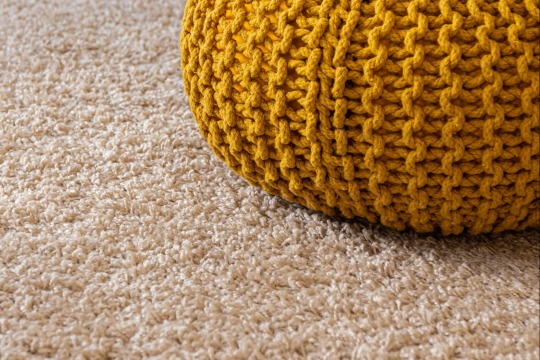
Introduction: Carpet Fibres: Natural, Synthetic or Blend?
When choosing the perfect carpet for your home or office, you need to carefully consider what the carpet’s fibres are made from. This will affect the appearance, texture, durability and ease of maintenance of the carpet. Also, for more environmentally conscious consumers, different fibres have different degrees of environmental impact. In this guide, we aim to take you through the most common carpet fibres available splitting them into three categories (Natural / Synthetic / Blend) to help you select the perfect carpet for your space!
Natural
As the name suggests, natural carpet fibres are made from organic products.
• Wool: Widely-considered the premium carpet fibre of choice, wool creates a soft and luxurious feeling underfoot. Wool is also naturally stain-resistant improving the carpet’s resilience and making maintenance easier. However, these premium features come with a matching price tag, as wool is one of the most expensive carpet fibres. It is also one of the most environmentally friendly, both in terms of creating the carpet and destroying it when its life is over.
• Sisal: Made from plant fibres, this carpet is much rougher than wool making it suitable for commercial spaces with heavy footfall. This carpet fibre would suit a company wanting to promote their environmentally friendly policy.
• Cotton: A natural fibre that offers a soft feel underfoot, but is prone to staining and crushing, so not suitable for high spill or high traffic areas.
• Silk: Probably the ultimate luxury carpet, silk is incredibly soft underfoot and not suited for high traffic areas.
• Jute: A tougher natural fibre meaning jute can handle heavier traffic but does not feel as soft underfoot. It does however provide a wonderful natural-looking finish.
• Seagrass: Like jute, seagrass is tougher but rougher underfoot. It offers a natural finish, but often requires specialist care (like jute).
Synthetic
Synthetic fibres are man-made, artificial fibres made from inorganic materials.
• Nylon: Probably the most common synthetic carpet material, nylon is incredibly durable and resistant making it an excellent choice for high traffic or high spill areas. Nylon also benefits from a wide range of colour and pattern choices available, so there will surely be a nylon carpet that suits your style. With lots of styles comes lots of prices, lower quality nylon carpet is very affordable but may fade and compress over time. Whereas higher quality nylon carpet is more expensive but is well worth the investment for its superior wear resistance.
• Polyester: Polyester carpets look luxurious and feel soft underfoot. They are also stain-resistant thanks to their synthetic nature and repels water well. Like nylon, polyester carpets have a wide range of colours and patterns available. However, when compared to nylon, polyester is less resilient and durable. It is usually more affordable than nylon.
• Polypropylene (Olefin): This synthetic carpet fibre is affordable and resistant to moisture making it the best carpet choice for bathrooms and conservatories. Whilst it is easy to maintain, it is not as soft underfoot and is prone to matting over time.
• Triexta (PPT): Relatively new to the market, Triexta has the benefits of stain resistance and durability whilst also maintaining a softness underfoot. This carpet fibre has proven popular in houses with pets, as the synthetic fibres can resist paws, stains and the constant vacuuming of fur whilst also maintain a warm, homely feel. Also, as far as synthetic fibres go, Triexta is environmentally friendly as the fibre is partially made from renewable resources.
Blends
Some carpet manufacturers mix the materials they use to make fibres, and these are called blends. A common blend is a nylon-wool fibre. This combines the strengths of natural fibres with the strengths of synthetic fibres. For example, a nylon-wool blend carpet has the durability of nylon and the softness of wool combined. There are other blends too, so shop around for the combination that suits your needs.
Natural vs Synthetic
Let’s pit natural fibres against synthetic fibres over a series of carpet considerations to see which fibre comes out on top.
• Cost: Natural fibres tend to be more expensive than synthetic fibres.
• Traffic: Synthetic fibres tend to be more durable than natural fibres making them better suited for high traffic areas.
• Pets: Synthetic fibres are better suited to homes with pets than natural fibres, as synthetic fibres have some moisture resistance.
• Maintenance: Synthetic fibres tend to be easier to maintain than natural fibres.
Synthetic fibres win this head-to-head dual. However, at Flooring Hut, we would encourage you to consider a blend carpet as it offers the best of both natural and synthetic fibres.
Conclusion
When it comes to choosing the perfect carpet for your home or office space, the main thing to consider is which fibre you want. Natural fibres offer softness underfoot, a touch of luxury and are environmentally conscious. On the other hand, synthetic fibres are more affordable, more durable and easier to maintain. Alternatively, you can go for the best of worlds and get a blended carpet. We hope this guide has helped you to choose the best carpet fibre for your needs.
Read the full article
0 notes
Text
How to Choose The Best Flooring for Kitchen
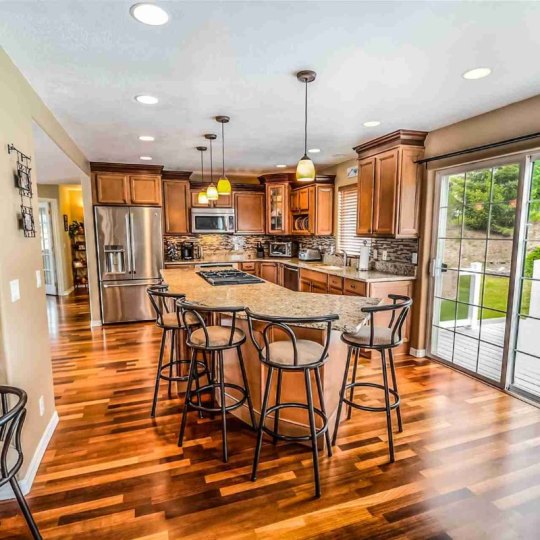
The kitchen is one of the most-used rooms in the house - we prepare food here, stand and chat, and many people have a kitchen/dining room combo with a dining table where meals are eaten. Aside from the living room, it is often described as the focal point of the house, so a decision like choosing the kitchen flooring is especially important.
Because of the high usage and potential for spills and heavy drops, the best flooring for kitchen areas should be robust, durable, and easy to maintain. But which are considered the most popular flooring types and how can you choose the right one? I take a look at this in the below guide - enjoy!
Popular Kitchen Flooring Options
To get right into it, let’s take a look at the most popular kitchen flooring options including vinyl, tile, and laminate to name a few examples.
Vinyl Flooring
LVT flooring is especially durable, easy to install and is available in a wide range of patterns and styles that mimic wood, stone, and concrete. These are available as planks or tiles and oftentimes can be installed without professional help.
Hardwood Flooring
Hardwood flooring is made from solid wood such as oak, maple, and hickory. This flooring looks incredible but is usually the most expensive choice and more difficult to maintain.
Tile Flooring
Traditional ceramic tiles look fantastic and have a great variety of colours and styles. The harder materials they are made from make them durable, but this also means they can be prone to chips and damage.
Laminate Flooring
Laminate flooring is usually the cheapest kitchen flooring option available but it offers a diverse range of colours, styles, and patterns, and the maintenance is excellent.
Cork Flooring
Cork flooring is relatively cheap and gives your kitchen a more rustic look. It’s great for maintenance and if you want a flooring with minimum upkeep it’s a great choice.
Engineered Wood Flooring
Engineered wood flooring is cheaper than hardwood flooring as it has a top layer of solid wood, but a core of cheaper compressed wooden fibres.
Durability and Resistance
Kitchen floors are perhaps the most prone to wear and tear, spills, and damage. Meals are prepared in the kitchen and food and liquids can easily be spilt. Also, it’s not uncommon to drop things like dishes, saucepans, and cutlery - I smashed a plate only last week on my kitchen floor!
This increased chance of drops and spills can damage floors easily. Therefore, if you are prone to clumsiness, you may want to invest in a flooring type that doesn’t dent or scratch as easily such as vinyl or laminate.
Maintenance Considerations
Due to the high usage of kitchen floors, you have to consider the maintenance too. How easy is the flooring type to clean? For example, LVT click flooring is one of the easiest types to clean as you can lightly mop it and wipe away stains in seconds.
In contrast, hardwood flooring can soak up stains and tile flooring scratches and dents much easier than vinyl or laminate. You have to select the best flooring for kitchen areas that you can easily maintain and that fits with your usage levels.
Style and Aesthetics
Everyone wants their kitchen flooring to look good so style and aesthetics play a huge role in the decision-making process too. I find that a great starting point is looking at your kitchen units and decor to see what colour scheme you want to use and which floor colour would work the best.
For example, if you have darker wood kitchen units, you may want a lighter flooring option that adds a little contrast.
With a colour scheme decided, you should be able to narrow down the suitable flooring options. Hardwood, cork, and engineered wood flooring are more limited in terms of colour options as they typically reflect natural wood colours. In contrast, vinyl and laminate flooring can mimic a range of styles including wood, stone, and concrete and thus usually have a wider range of colours and patterns.
Budget Considerations
Cost is always sadly a consideration and most people have a set budget to work to. This is unavoidable and if you are looking for a budget option, traditional laminate flooring is considered the best option.
Vinyl flooring is also budget-friendly without sacrificing quality, while hardwood flooring is one of the most expensive options but offers the best longevity and durability.
Find The Right Kitchen Flooring Solution for Your Needs
I hope you are now more informed and have some insight into choosing the best flooring for kitchen areas. There is no definitive answer and you have to look at factors like cost, suitability, and who lives in your household. With these things in mind, you should be able to select the right flooring that gives value for money and will withstand your family usage.
Read the full article
0 notes
Text
How to Choose The Best Flooring for Living Room
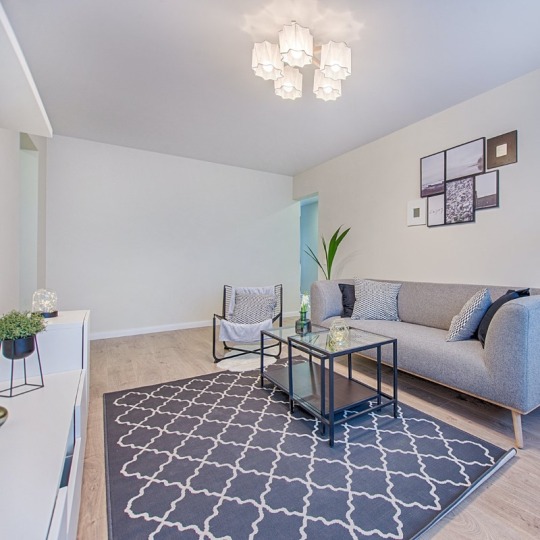
The room in my house where I spend the most time is the living room and I expect this to be the same for most households. It’s called a living room for a reason as we do most of our living in it! These rooms are where we relax after work, sit in the morning with a coffee, and spend precious family time together.
Because of the importance of the living room, you want to make sure that every aspect of yours is perfect, including the flooring. Below, I take a look at how to choose the best flooring for living room areas including common factors like comfort and style, and give you some popular options to think about.
Comfort and Texture
Most evenings I relax in my living room so I want the flooring to be comfortable and warm and I bet that most families feel the same way. If you do value comfort above everything else, carpets and rugs are the best options.
These have the best soundproofing, offer the best cushioning for walking on, and make your living room warmer. Rigid core LVT options and laminate flooring are also comfortable but slightly colder, and hardwood flooring and tiles can often make living rooms cold and are much harder to walk on.
Style and Aesthetics
While comfort is important, you can’t overlook the style and aesthetics of your living room flooring. As it’s a room you use so often and a room where you will entertain guests, you want your living room to look fantastic!
Consider the decor and colours you have in your living room including the furniture and walls. How would different flooring styles match with this decor? Would a particular color fit well? If so, which flooring types is it available in?
Remember that some flooring types like hardwood floors and engineered wood floors have a limited selection of colours and patterns compared to LVT flooring and carpet which are much more versatile.
Withstanding Daily Wear and Tear
I can’t count the number of times I walk through my living room daily! Aside from my stairs, it’s easily the floor that sees the most traffic and I am sure most people are the same. This means that you have to choose a flooring type that is durable and can withstand daily wear and tear.
The wear and tear is only compounded if you have children and pets. LVT, laminate, and hardwood floors all have excellent durability and can withstand high traffic easily. Carpet is relatively robust too, but with constant wear, the pile can become thinner and it can lose its padding over time.
Ease of Cleaning and Maintenance
Many people eat their meals in the living room and have drinks while watching TV. Combine this with the increase foot traffic and living room flooring can easily become dirty and need repairs. Out of the floor types, carpet is not the best flooring for living room areas as it is the most difficult to clean stains and dirt from.
In contrast, if you have a particularly messy household, you could benefit from flooring like LVT, laminate, or engineered hardwood that is much easier to clean.
Popular Living Room Flooring Options
Some flooring options are better than others for living rooms and I have listed my top picks below.
Vinyl Flooring
LVT flooring offers more comfort and warmth and better soundproofing compared to hardwood floors and tiles, but it is still colder than carpet. You can get vinyl floors in a range of styles that emulate traditional floors like wood, stone, and concrete.
Carpet
Carpet is the favoured option for many in the living room as it’s the most comfortable and warm choice with the best soundproofing. Available in a myriad of colours and patterns, the only drawback is the maintenance and cleaning.
Hardwood Flooring
Hardwood floors made from woods like oak and maple look amazing and they are a great choice if you want to make a statement with your flooring. However, they can be cold and are one of the most expensive options.
Area Rugs
You can complement a hard floor like LVT, laminate, tiles, or hardwood with an area rug. This negates some of the coldness and adds an extra layer of padding and comfort.
Tile Flooring
Tiles are uncommon in living rooms and they are typically more favored in kitchens, but they can make your living room flooring stand out and could be a great choice if you have messy children and pets!
Find the Right Flooring for Your Living Room Today
Because of the importance of the living room in most households, I urge you to think about the flooring options carefully. Oftentimes this is the room where we spend the most time so you want it to look great, fit with your decor, but also be comfortable and make the room pleasant to relax in. Hopefully, the considerations I have listed above should help you find the best flooring for living room areas in your home!
Read the full article
0 notes
Text
How to Choose the Best Flooring for Conservatory

Oftentimes more thought is given to the structure, glass, and furniture in a conservatory, but what about the flooring? Conservatory flooring is especially important due to the weather and temperature conditions compared to other rooms in your home. If you choose the wrong flooring, it could fade quickly or get moisture damage for example.
Below, I look at the best flooring for conservatory extensions together with some key factors to consider such as sunlight, moisture, and aesthetic choices.
Sunlight and Temperature Considerations
The point of a conservatory is to be a place where you can relax, get closer to the outdoors, and enjoy the sunlight. This means that most conservatories are prominently made from glass with a UPVC frame.
As a result, the contents of a conservatory including the flooring are subject to a near constant barrage of sunlight and UV rays. You therefore need to choose a flooring type that is UV-resistant and won't fade easily.
Also consider the temperature as conservatories are usually especially hot during the summer, but can be incredibly cold in the winter. You want flooring that neutralizes those extremes in temperature if possible.
Moisture and Humidity Resistance
Conservatories are also subject to differing moisture and humidity levels and they can be prone to condensation. Because of this, you need a flooring type that has some degree of water resistance such as vinyl flooring or ceramic tiles.
It may mean that other flooring types like carpets are not suitable because they can absorb moisture and get damaged easily.
Coordinating Flooring With Conservatory Design
Although practicality should be your first consideration, I get that you want your conservatory to look fantastic too which is why you have to consider the aesthetics and style of your flooring.
Typically, conservatories are light as they feature plenty of glass and white UPVC frames which is why a darker flooring option to add a little contrast could be a great option. Wood or stone effect flooring such as LVT is available in a myriad of colors and patterns that contrast perfectly with the light nature of conservatories for example.
Also, think about the furniture you have and how this will fit your flooring choice. Aesthetics and style are the parts you can have some fun with!
Best Flooring for Conservatories
Some types of flooring work brilliantly in conservatories while others just don’t work like carpet. Below, I have listed my top picks for the best flooring for conservatory extensions.
Luxury Vinyl Tile (LVT)
LVT flooring is available in tiles or planks and is made mainly from vinyl with a protective top wear layer and a solid vinyl core. This is the best flooring for conservatory areas due to its versatility. It offers water resistance and UV protection so it won’t fade or get damaged easily by moisture.
Additionally, LVT flooring is warmer than stone floors or ceramic tiles, and it is available in designs that mimic wood, stone, and concrete floors. You can easily get a style to match your conservatory decor.
Porcelain or Ceramic Tiles
Tiles are another great choice because of their durability and resistance to water damage and UV damage. They are one of the most durable flooring types and offer better durability than LVT flooring.
The downside is that during the winter they are incredibly cold and don’t do anything to make your conservatory warmer.
Engineered Wood Flooring
Compared to traditional hardwood flooring, engineered wood flooring is a cheaper alternative. It has a solid wood top and bottom layer, but an engineered wood core made from cheaper materials.
This means you still get a fantastic look and it is one of the more stylish options for your conservatory. The downside is that because the floor is real wood, it is subject to water damage as it can seep into the planks and cause warping.
Stone Flooring
Stone flooring is one of the more expensive options but like tiles, it offers some of the best durability to combat the sunlight and harsher conditions of conservatories. Stone floors are also easy to clean when people potentially trample dirt in from the garden!
Like tiles, stone flooring can be especially cold in autumn and winter which could limit the usability of your conservatory during these seasons.
Bamboo Flooring
Bamboo flooring serves as an alternative to engineered wood flooring and it has the benefit of being water-resistant so it shouldn’t warp. The downside is the limited color palette and patterns compared to other types of conservatory flooring.
Finish Your Conservatory With the Right Flooring
Due to the extreme variances in temperatures and humidity, plus the sun exposure, it’s especially important to choose the best flooring for conservatory extensions. You need a durable flooring type, can withstand UV rays, but also enhances the aesthetics of the room and makes it comfortable regardless of the season.
Read the full article
0 notes
